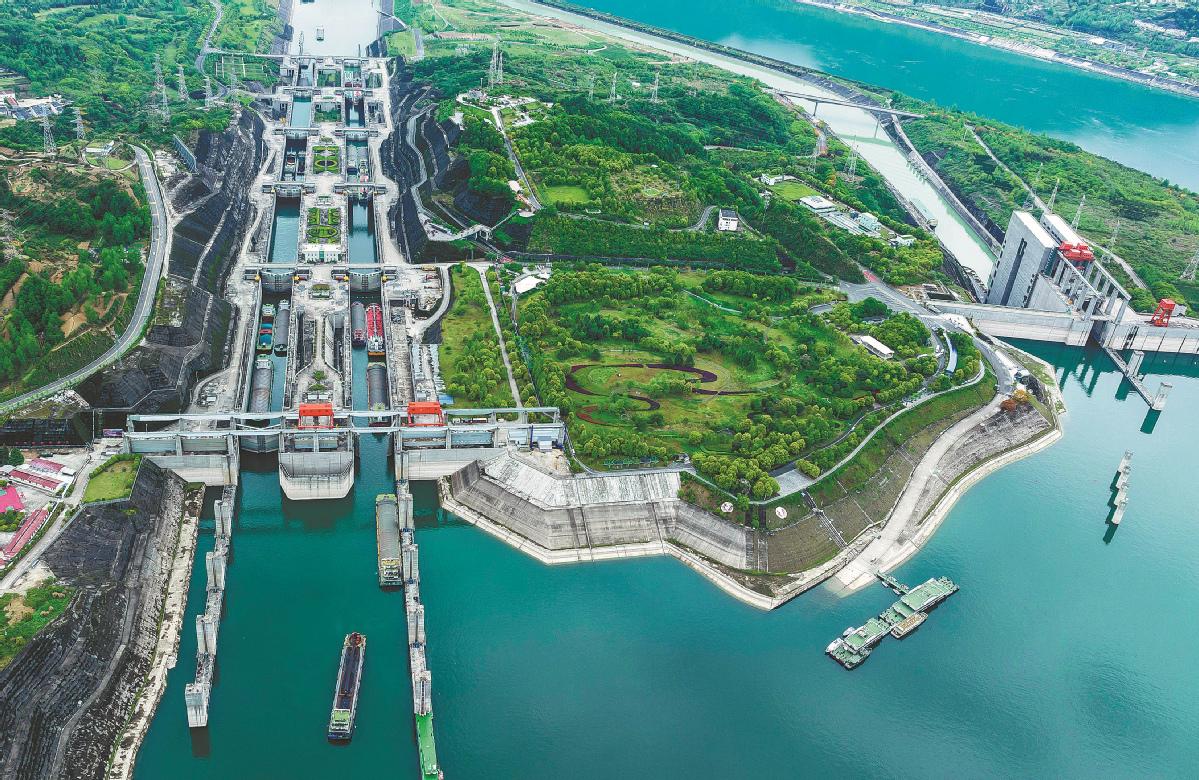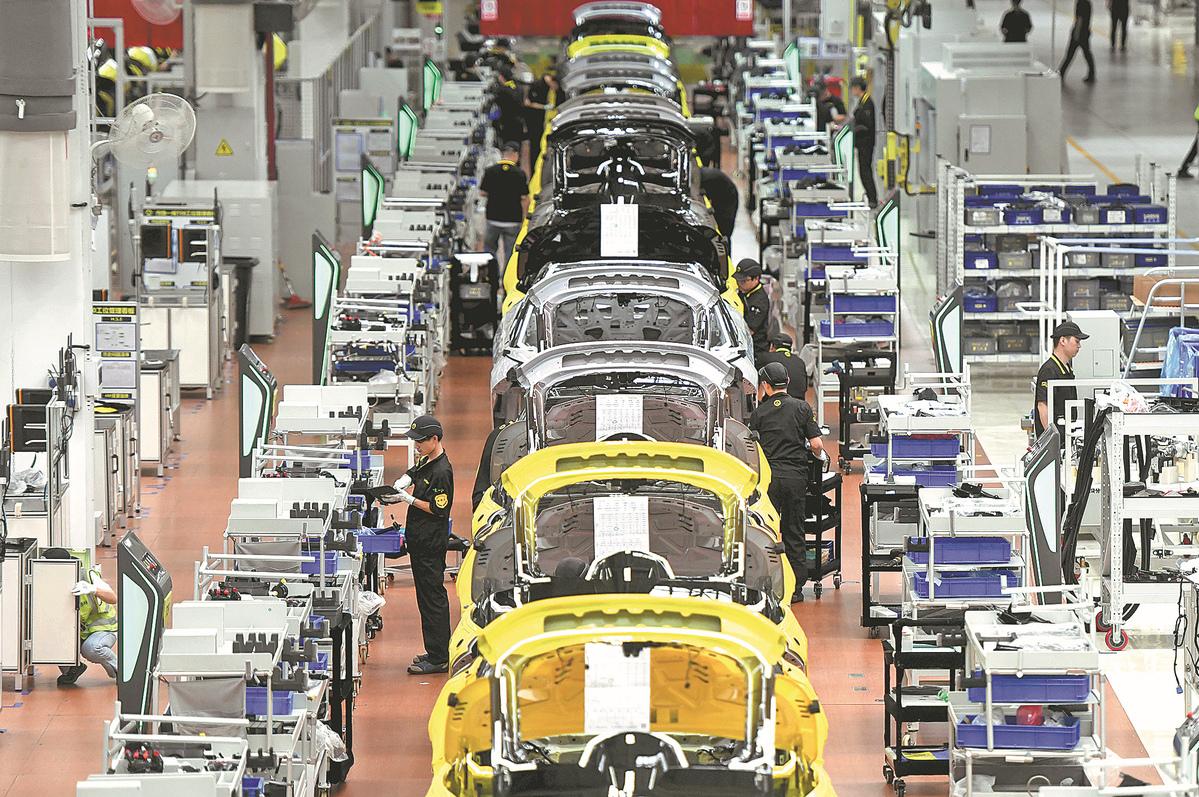China Daily | September 14, 2023

Ships pass through a lock on the Three Gorges Dam in April. The dam's annual freight volume has surpassed 100 million metric tons for the past five years. ZHENG JIAYU/XINHUA
A row of buildings stands in the background as the sun blazes down on neat roads alongside lush lawns and newly planted saplings anchored to the ground by wooden supports.
At first sight, this appears to be just another typical newly built office compound that can be seen in many areas of China. But staff members wearing safety vests and helmets, a chimney emitting white smoke and pipelines rising high into the air serve to remind visitors that they have entered a chemical factory.
Located in the Yaojiagang Chemical Industrial Park in Zhijiang, Yichang city, Hubei province, the factory is a production base for local enterprise Hubei Sanning Chemical Industry Co.
The base, which can produce 600,000 metric tons of ethylene glycol a year, is supported by smart technologies, including 5G. Ethylene glycol is used as an antifreeze, and in the manufacture of polyester.
Yang Wenhua, an employee at the company who led the establishment of the smart system, said that with the help of such technologies, the factory has significantly improved the safety and efficiency of production.
The smart system also helps reduce the amount of harmful byproducts formed — making the entire manufacturing process more environmentally friendly, Yang said.
The company is one of 108 operating at the industrial park, which was established in 2008.
Xia Kesong, director of the Zhijiang high-tech zone management committee, which oversees the park, said most companies operating there used to focus on manufacturing chemical fertilizers.
Now, they have expanded to sectors such as new materials and biomedicine, Xia said.
The park boasts a sound supply chain, as products and even byproducts made by some companies are raw materials for others. This, in turn, reduces logistics and treatment costs, Xia said.
The park is planning to attract more high-quality and competitive companies.
"We run a strict review of companies which want to do business at the park, to assess five aspects — their safety, environmental friendliness, energy consumption, profits and investment," Xia said, adding that the park has rejected many unqualified candidates.
Development of the park serves as a vivid example of how Yichang, a city on the Yangtze River that used to rely heavily on the chemical industry, is upgrading this industry and reducing its impact on the environment.
President Xi Jinping has emphasized on different occasions the importance of protecting the Yangtze River.
At a symposium in Chongqing in 2016 on improving development of the Yangtze River Economic Belt, Xi stressed that this is an overwhelmingly important task to restore the river's ecology and the environment.
Two years later, during an inspection visit to Hubei in 2018, Xi said in Yichang that the economic belt should be developed in a scientific and orderly manner, and this development must not undermine the environment.
Inspired by Xi's words, the authorities in Yichang launched strenuous efforts to improve the environment of the Yangtze.
More than 130 chemical companies located within 1 kilometer of the river have been closed or relocated, while stringent measures have been taken to ensure wastewater is properly treated.
Chen Xiaoqing, assistant general manager of Xingfa Group, a local chemical company, said the factory has closed its wastewater outlets into the Yangtze. The wastewater is now sent to a government-built sewage treatment plant.
Before being accepted by the plant, the wastewater must be treated according to government requirements, which Chen said are "very high".
Chen said that to meet these requirements, the company spent a large amount on upgrading its equipment.
This was a "rather painful" process at first, but now the company's "greatest core competency" is the ability to reduce its environmental impact, Chen added.
The story of Yichang, located in western Hubei, illustrates the efforts made by the authorities to improve the province's growth pattern and pursue high-quality development.
Hubei Daily reported that earlier this year, Hubei issued a guideline to further advance its chemical industry.
The provincial government said in the guideline that chemical companies in the province should manufacture high-quality raw materials, and work to overcome technical challenges to provide high-end products and those that are in short supply.
It is strictly forbidden to set up chemical industrial parks in places such as nature reserves, source water conservation areas, and areas within 1 km of the Yangtze River, the government said.
The government also issued a three-year action plan to improve safety at chemical industrial parks in the province.

Workers operate machinery on the production line at a smart factory in Wuhan, capital of Hubei province. CHENG MIN/XINHUA
Economic drivers
In addition to working to improve the performance of the chemical industry, the authorities in Hubei are striving to advance other traditional industries, such as the automobile sector, to achieve better growth.
Hubei is a major automobile manufacturing base. In 2021, about 2.1 million vehicles were produced in the province, accounting for 8 percent of China's total.
As the new energy vehicle, or NEV, industry gains ever stronger momentum in China, Hubei is looking to turn itself into an innovation hub and manufacturing base for new energy and smart vehicles, one of five emerging industries the province aims to promote to further hone its competitiveness.
A number of NEV companies and battery makers are operating in the province, which has set a goal of raising the value of its new energy vehicle industry to more than 300 billion yuan ($41 billion) by next year.
These companies include Xiangyang Tenglong Automobile Co, which began operating in Xiangyang city in northern Hubei in 2017 to produce new energy buses and multipurpose vehicles. The company is headquartered in Jiangsu province.
Zhou Shengming, deputy general manager of Tenglong, said the company chose Xiangyang because of the city's welcoming business environment.
The local government is very supportive, and the company enjoys preferential tax and land use policies, he said.
The city also provides a steady supply chain for car companies.
Automobiles have been made in Xiangyang for four decades, and the city is home to several hundred car manufacturers and auto parts factories.
Over the past 10 years, Xiangyang has kept pace with growth of the NEV industry.
In 2013, the central government released a list of 28 cities and regions, including Xiangyang, to support in promoting the use of NEVs.
In 2021, Xiangyang drew up an action plan to transform its automobile industry, and decided to establish a special fund for promoting NEVs.
Zhou said of all the auto parts his company uses to make vehicles, 60 to 70 percent are provided by companies in Xiangyang or other areas of Hubei.
"You can buy all the auto parts you want here," he said, adding that his company now produces and sells 4,000 to 5,000 vehicles a year. Some 15 percent of them are exported to countries such as Indonesia, Malaysia and Egypt.
Another example of Xiangyang's determination to boost its NEV industry is the launch of a battery factory by new energy vehicle manufacturer BYD.
The city government signed an agreement with BYD in January last year, and adopted a series of measures to pave the way for the early opening of the factory.
Construction of the plant started in April last year, and its first production line went into operation in December.
Zhang Dada, an employee at BYD's battery-making subsidiary, said such a fast pace demonstrates the high level of importance the Xiangyang government places on the NEV industry.
In addition to Xiangyang, several other cities in Hubei are included in the province's strategy to further reinforce its automobile industry.
It is working on establishing an "automobile industry corridor "running southeast to northwest and covering the cities of Wuhan, Xiaogan, Suizhou, Xiangyang and Shiyan. The aim is to make these cities an automobile production base for the whole country.
Hubei also plans to strengthen the automobile industry by introducing emerging technologies, including artificial intelligence and big data. The province has a traditional advantage in convenient transportation links, giving it a competitive edge in developing various industries, including the automobile sector.
The interwoven network of air routes, railways, highways and waterways in Hubei make the province a transportation hub connecting east and west, and north and south.
Zhang said an important reason for BYD opening its battery factory in Xiangyang is that the city's location makes it easy to reach most other provinces in the country.
To seize more opportunities for growth, Hubei is aiming to become an international transportation hub.
In July last year, Huahu Airport opened in Ezhou city, Hubei. It mainly handles cargo flights, and the provincial authorities hope to make the airport an inland free-trade port.
One year on, the airport has launched cargo flights to eight overseas destinations, including Liege, Belgium; Chennai, India; Frankfurt, Germany; and Los Angeles and New York in the United States.
As of mid-July, the airport, jointly constructed by the provincial government and delivery and logistics company SF Express, had handled 203 international flights carrying more than 8,700 tons of cargo.
Yu Ke, executive vice-mayor of Ezhou, said that as part of measures to increase the airport's competitiveness, the city is inviting major cargo airlines, international logistics companies and freight forwarders to base themselves at the facility.
Yu said at a news conference in April that the local government also encourages airlines based at Huahu Airport to establish cargo bases overseas and strengthen their cooperation with major international air cargo hubs.
"In this way, we hope to create a highly efficient new Silk Road in the air to expand world trade," Yu said.

